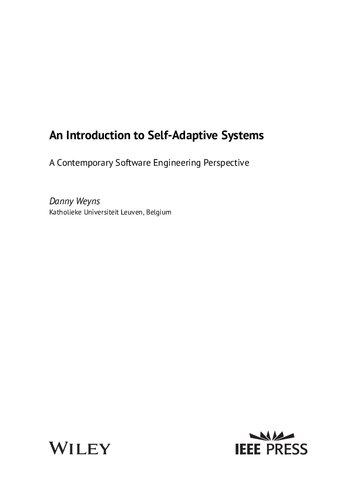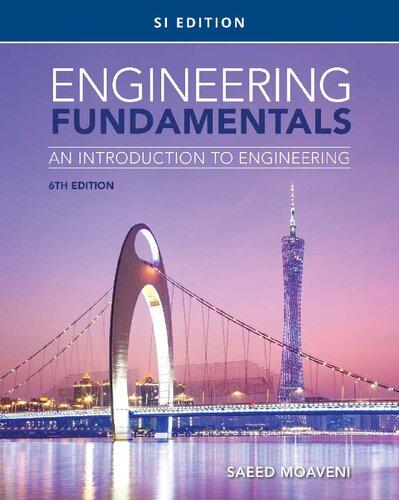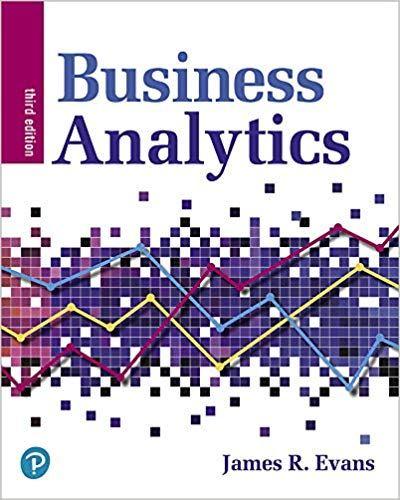
https://ebookmass.com/product/an-introduction-to-selfadaptive-systems-a-contemporary-software-engineeringperspective-danny-weyns/

Instant digital products (PDF, ePub, MOBI) ready for you
Download now and discover formats that fit your needs...
Engineering Software Products: An Introduction to Modern Software Engineering Ian Sommerville
https://ebookmass.com/product/engineering-software-products-anintroduction-to-modern-software-engineering-ian-sommerville/
ebookmass.com
Engineering Fundamentals: An Introduction to Engineering, SI Edition Saeed Moaveni
https://ebookmass.com/product/engineering-fundamentals-anintroduction-to-engineering-si-edition-saeed-moaveni/
ebookmass.com
Engineering Fundamentals: An Introduction to Engineering, 6th Edition Moaveni Saeed
https://ebookmass.com/product/engineering-fundamentals-anintroduction-to-engineering-6th-edition-moaveni-saeed/
ebookmass.com
(eTextbook PDF) for Business Analytics 3rd Edition by
James R. Evans
https://ebookmass.com/product/etextbook-pdf-for-businessanalytics-3rd-edition-by-james-r-evans/
ebookmass.com




The Companion and the Earl Rose Pearson
https://ebookmass.com/product/the-companion-and-the-earl-rose-pearson/
ebookmass.com
Theory and Design for Mechanical Measurements, 6th Edition 6th Edition, (Ebook PDF)
https://ebookmass.com/product/theory-and-design-for-mechanicalmeasurements-6th-edition-6th-edition-ebook-pdf/
ebookmass.com
Instructor Manual for Corrections: The Essentials 2nd Second Edition, Mary K. Stohr, Anthony Walsh
https://ebookmass.com/product/instructor-manual-for-corrections-theessentials-2nd-second-edition-mary-k-stohr-anthony-walsh/
ebookmass.com
Extra Witchy Ann Aguirre
https://ebookmass.com/product/extra-witchy-ann-aguirre-3/
ebookmass.com
Counseling and psychotherapy : theories and interventions 7th Edition David Capuzzi
https://ebookmass.com/product/counseling-and-psychotherapy-theoriesand-interventions-7th-edition-david-capuzzi/
ebookmass.com





https://ebookmass.com/product/czech-mate-1st-edition-paulin/
ebookmass.com

AnIntroductiontoSelf-AdaptiveSystems
AContemporarySoftwareEngineeringPerspective
DannyWeyns
KatholiekeUniversiteitLeuven,Belgium
Thiseditionfirstpublished2021 ©2021JohnWiley&SonsLtd
Allrightsreserved.Nopartofthispublicationmaybereproduced,storedinaretrievalsystem,or transmitted,inanyformorbyanymeans,electronic,mechanical,photocopying,recordingorotherwise, exceptaspermittedbylaw.Adviceonhowtoobtainpermissiontoreusematerialfromthistitleisavailable athttp://www.wiley.com/go/permissions.
TherightofDannyWeynstobeidentifiedastheauthorofthisworkhasbeenassertedinaccordance withlaw.
RegisteredOffices
JohnWiley&Sons,Inc.,111RiverStreet,Hoboken,NJ07030,USA
JohnWiley&SonsLtd,TheAtrium,SouthernGate,Chichester,WestSussex,PO198SQ,UK
EditorialOffice
TheAtrium,SouthernGate,Chichester,WestSussex,PO198SQ,UK
Fordetailsofourglobaleditorialoffices,customerservices,andmoreinformationaboutWileyproducts visitusatwww.wiley.com.
Wileyalsopublishesitsbooksinavarietyofelectronicformatsandbyprint-on-demand.Somecontentthat appearsinstandardprintversionsofthisbookmaynotbeavailableinotherformats.
LimitofLiability/DisclaimerofWarranty
Whilethepublisherandauthorshaveusedtheirbesteffortsinpreparingthiswork,theymakeno representationsorwarrantieswithrespecttotheaccuracyorcompletenessofthecontentsofthisworkand specificallydisclaimallwarranties,includingwithoutlimitationanyimpliedwarrantiesofmerchantability orfitnessforaparticularpurpose.Nowarrantymaybecreatedorextendedbysalesrepresentatives,written salesmaterialsorpromotionalstatementsforthiswork.Thefactthatanorganization,website,orproduct isreferredtointhisworkasacitationand/orpotentialsourceoffurtherinformationdoesnotmeanthat thepublisherandauthorsendorsetheinformationorservicestheorganization,website,orproductmay provideorrecommendationsitmaymake.Thisworkissoldwiththeunderstandingthatthepublisheris notengagedinrenderingprofessionalservices.Theadviceandstrategiescontainedhereinmaynotbe suitableforyoursituation.Youshouldconsultwithaspecialistwhereappropriate.Further,readersshould beawarethatwebsiteslistedinthisworkmayhavechangedordisappearedbetweenwhenthisworkwas writtenandwhenitisread.Neitherthepublishernorauthorsshallbeliableforanylossofprofitorany othercommercialdamages,includingbutnotlimitedtospecial,incidental,consequential,orother damages.
LibraryofCongressCataloging-in-PublicationDataappliedfor ,
HardbackISBN:9781119574941
CoverDesign:Wiley
CoverImage:©Takeshi.K/GettyImages
Setin9.5/12.5ptSTIXTwoTextbySPiGlobal,Chennai,India
PrintedandboundbyCPIGroup(UK)Ltd,Croydon,CR04YY 10987654321
Contents
Foreword xi
Acknowledgments xv
Acronyms xvii
Introduction xix
1BasicPrinciplesofSelf-AdaptationandConceptualModel 1
1.1PrinciplesofSelf-Adaptation 2
1.2OtherAdaptationApproaches 4
1.3ScopeofSelf-Adaptation 5
1.4ConceptualModelofaSelf-AdaptiveSystem 5
1.4.1Environment 5
1.4.2ManagedSystem 7
1.4.3AdaptationGoals 8
1.4.4FeedbackLoop 8
1.4.5ConceptualModelApplied 10
1.5ANoteonModelAbstractions 11
1.6Summary 11
1.7Exercises 12
1.8BibliographicNotes 14
2EngineeringSelf-AdaptiveSystems:AShortTourinSevenWaves 17
2.1OverviewoftheWaves 18
2.2ContributionsEnabledbytheWaves 20
2.3WavesOverTimewithSelectedWork 20
2.4Summary 22
2.5BibliographicNotes 23
3Internet-of-ThingsApplication 25
3.1TechnicalDescription 25
3.2Uncertainties 28
3.3QualityRequirementsandAdaptationProblem 29
3.4Summary 29
3.5Exercises 30
3.6BibliographicNotes 31
4WaveI:AutomatingTasks 33
4.1AutonomicComputing 34
4.2UtilityFunctions 35
4.3EssentialMaintenanceTasksforAutomation 37
4.3.1Self-Optimization 37
4.3.2Self-Healing 38
4.3.3Self-Protection 40
4.3.4Self-Configuration 42
4.4PrimaryFunctionsofSelf-Adaptation 43
4.4.1Knowledge 44
4.4.2Monitor 46
4.4.3Analyzer 47
4.4.4Planner 49
4.4.5Executor 51
4.5SoftwareEvolutionandSelf-Adaptation 52
4.5.1SoftwareEvolutionManagement 53
4.5.2Self-AdaptationManagement 54
4.5.3IntegratingSoftwareEvolutionandSelf-Adaptation 55
4.6Summary 56
4.7Exercises 59
4.8BibliographicNotes 60
5WaveII:Architecture-basedAdaptation 63
5.1RationaleforanArchitecturalPerspective 64
5.2Three-LayerModelforSelf-AdaptiveSystems 66
5.2.1ComponentControl 67
5.2.2ChangeManagement 67
5.2.3GoalManagement 68
5.2.4Three-LayerModelAppliedtoDeltaIoT 68
5.2.5MappingBetweentheThree-LayerModelandtheConceptualModelfor Self-Adaptation 70
5.3ReasoningaboutAdaptationusinganArchitecturalModel 70
5.3.1RuntimeArchitectureofArchitecture-basedAdaptation 71
5.3.2Architecture-basedAdaptationoftheWeb-basedClient-ServerSystem 73
5.4ComprehensiveReferenceModelforSelf-Adaptation 75
5.4.1ReflectionPerspectiveonSelf-Adaptation 76
5.4.2MAPE-KPerspectiveonSelf-Adaptation 78
5.4.3DistributionPerspectiveonSelf-Adaptation 79
5.5Summary 83
5.6Exercises 84
5.7BibliographicNotes 87
6WaveIII:RuntimeModels 89
6.1WhatisaRuntimeModel? 90
6.2CausalityandWeakCausality 90
6.3MotivationsforRuntimeModels 91
6.4DimensionsofRuntimeModels 92
6.4.1StructuralversusBehavioral 93
6.4.2DeclarativeversusProcedural 94
6.4.3FunctionalversusQualitative 95
6.4.3.1FunctionalModels 95
6.4.3.2QualityModels 95
6.4.4FormalversusInformal 98
6.5PrincipalStrategiesforUsingRuntimeModels 101
6.5.1MAPEComponentsShareKModels 101
6.5.2MAPEComponentsExchangeKModels 103
6.5.2.1RuntimeModels 103
6.5.2.2ComponentsoftheManagingSystem 104
6.5.3MAPEModelsShareKModels 105
6.6Summary 108
6.7Exercises 109
6.8BibliographicNotes 114
7WaveIV:Requirements-drivenAdaptation 115
7.1RelaxingRequirementsforSelf-Adaptation 116
7.1.1SpecificationLanguagetoRelaxRequirements 116
7.1.1.1LanguageOperatorsforHandlingUncertainty 116
7.1.1.2SemanticsofLanguagePrimitives 118
7.1.2OperationalizationofRelaxedRequirements 118
7.1.2.1HandingUncertainty 118
7.1.2.2RequirementsReflectionandMitigationMechanisms 119
7.1.2.3ANoteontheRealizationofRequirementsReflection 121
7.2Meta-RequirementsforSelf-Adaptation 122
7.2.1AwarenessRequirements 123
7.2.2EvolutionRequirements 124
7.2.3OperationalizationofMeta-requirements 126
7.3FunctionalRequirementsofFeedbackLoops 127
7.3.1DesignandVerifyFeedbackLoopModel 128
7.3.2DeployandExecuteVerifiedFeedbackLoopModel 130
7.4Summary 131
7.5Exercises 132
7.6BibliographicNotes 134
8WaveV:GuaranteesUnderUncertainties 137
8.1UncertaintiesinSelf-AdaptiveSystems 139
8.2TamingUncertaintywithFormalTechniques 141
8.2.1AnalysisofAdaptationOptions 141
8.2.2SelectionofBestAdaptationOption 143
8.3ExhaustiveVerificationtoProvideGuaranteesforAdaptationGoals 144
8.4StatisticalVerificationtoProvideGuaranteesforAdaptationGoals 149
8.5ProactiveDecision-MakingusingProbabilisticModelChecking 154
8.6ANoteonVerificationandValidation 160
8.7IntegratedProcesstoTameUncertainty 160
8.7.1StageI:ImplementandVerifytheManagingSystem 161
8.7.2StageII:DeploytheManagingSystem 162
8.7.3StageIII:VerifyAdaptationOptions,Decide,andAdapt 163
8.7.4StageIV:EvolveAdaptationGoalsandManagingSystem 163
8.8Summary 164
8.9Exercises 165
8.10BibliographicNotes 168
9WaveVI:Control-basedSoftwareAdaptation 171
9.1ABriefIntroductiontoControlTheory 173
9.1.1ControllerDesign 174
9.1.2ControlProperties 175
9.1.3SISOandMIMOControlSystems 176
9.1.4AdaptiveControl 177
9.2AutomaticConstructionofSISOControllers 177
9.2.1PhasesofControllerConstructionandOperation 178
9.2.2ModelUpdates 179
9.2.3FormalGuarantees 181
9.2.4Example:Geo-LocalizationService 183
9.3AutomaticConstructionofMIMOControllers 184
9.3.1PhasesofControllerConstructionandOperation 184
9.3.2FormalGuarantees 186
9.3.3Example:UnmannedUnderwaterVehicle 186
9.4ModelPredictiveControl 189
9.4.1ControllerConstructionandOperation 189
9.4.2FormalAssessment 191
9.4.3Example:VideoCompression 192
9.5ANoteonControlGuarantees 194
9.6Summary 194
9.7Exercises 196
9.8BibliographicNotes 199
10WaveVII:LearningfromExperience 201
10.1KeepingRuntimeModelsUp-to-DateUsingLearning 203
10.1.1RuntimeQualityModel 204
10.1.2OverviewofBayesianApproach 205
10.2ReducingLargeAdaptationSpacesUsingLearning 208
10.2.1IllustrationoftheProblem 208
10.2.2OverviewoftheLearningApproach 210
10.3LearningandImprovingScalingRulesofaCloudInfrastructure 213
10.3.1OverviewoftheFuzzyLearningApproach 214
10.3.1.1FuzzyLogicController 214
10.3.1.2FuzzyQ-learning 217
10.3.1.3Experiments 221
10.4Summary 223
10.5Exercises 225
10.6BibliographicNotes 226
11MaturityoftheFieldandOpenChallenges 227
11.1AnalysisoftheMaturityoftheField 227
11.1.1BasicResearch 227
11.1.2ConceptFormulation 228
11.1.3DevelopmentandExtension 229
11.1.4InternalEnhancementandExploration 229
11.1.5ExternalEnhancementandExploration 230
11.1.6Popularization 230
11.1.7Conclusion 231
11.2OpenChallenges 231
11.2.1ChallengesWithintheCurrentWaves 231
11.2.1.1EvidencefortheValueofSelf-Adaptation 231
11.2.1.2DecentralizedSettings 232
11.2.1.3Domain-SpecificModelingLanguages 232
11.2.1.4ChangingGoalsatRuntime 233
11.2.1.5ComplexTypesofUncertainties 233
11.2.1.6ControlPropertiesversusQualityProperties 234
11.2.1.7Search-basedTechniques 234
11.2.2ChallengesBeyondtheCurrentWaves 235
11.2.2.1ExploitingArtificialIntelligence 235
11.2.2.2DealingwithUnanticipatedChange 236
11.2.2.3TrustandHumansintheLoop 236
11.2.2.4EthicsforSelf-AdaptiveSystems 237
11.3Epilogue 239
Bibliography 241 Index 263
Foreword
Fromtheearliestdaysofcomputing,theoristsrecognizedthatoneofthemoststriking aspectsofcomputationisitspotentialabilitytochangeitself:ratherthanpresentingusers withafixedsetofcomputationsdeterminedatdeployment,thesystemcouldatruntime modifybothwhatitcomputesandhowitcomputesit.However,while“self-modification” wasperhapsinterestingfromatheoreticalpointofview,fewprogrammingsystemsand engineeringmethodsembracedthiscapability–theadvantagesofdoingsowerenotobviousgiventheadditionalcomplexityofreasoningaboutsystembehaviorandthepotential forinadvertentlymakingareallybigmessofthings.
Overthepastdecade,however,self-adaptivesystemshaveemergedasafundamental elementofmodernsoftwaresystems.Virtuallyallenterprisesystemshavebuilt-inadaptive mechanismstohandlefaults,resourcemanagement,andattacks.Increasinglysystemsare takingovertasksotherwiseperformedbyhumansintransportation(automateddriving), medicine(assisteddiagnosis),environmentalcontrol(smartbuildings),andmanyothers.
Inthebroadfieldofsoftwareengineeringthesechangeshavebeenmirroredinanumber ofseismicshifts.Thefirsthasbeenashiftinfocusfromdevelopmenttimetoruntime.For mostofitshistory,softwareengineeringprimarilyfocusedongettingthings“right”before asystemwasdeployed.Whenproblemswereencountered,systemsweretakenoff-lineand fixedbeforeredeployment.Thismadesensebecausefewsystemsrequirednon-stopavailabilityandhencetheycouldbetakendownfor“scheduledmaintenance.”Buttodayalmost allpublicfacingsystemsmustbecontinuouslyavailable,requiringthatsystemsbemodifiable(eitherautomaticallyorbydevelopers)whiletheycontinuetooperate.
Asecondshifthasbeentheincreasinglevelofuncertaintythataccompaniesmodern systems.Inthepast,softwarewastypicallydevelopedforaknownenvironmentusingcomponentsthatwerelargelyunderthecontrolofthedevelopers.Todaysystemsworkinmuch moreuncertaincontexts:loadscanchangedramatically;resources(suchasnetworkbandwidth)canvarysubstantiallyformobilecomputing;faultscanarisefrominteractionwith othersystemsandresourcesoutsidethecontrolofthedeveloper;andattackscanemerge inunexpectedways.
Athirdshifthasbeenaninterestinautomationtoreducethecostofoperations.Inthe 1980sitwasrecognizedthatwhilethecostofacquiringordevelopingincreasinglycomplex
computingsystemswassteadilydeclining,theoverallcostofownershipwasrising.The reasonforthiswastheneedforsystemadministration,whichwastakingupalargerand largerfractionoftheIToperationalbudget.Byautomatingmanyoftheroutinefunctions performedbyadministrators,systemswouldbecomemoreaffordable.Moreover,arguably, fortoday’scomplexsoftwaresystems,completehumanoversightandcontrolissimplynot possible.
AfourthshifthasbeenthecommoditizationofAI.Whereasformuchofitsexistence AIhadlargelybeenrelegatedtospecialniches(e.g.,robotics),theincreasingavailabilityof planners,machinelearning,geneticalgorithms,andgame-theoreticdecisionsystemshas madeitpossibletoharnesssophisticatedreasoningandlearningmechanismsinsupportof automation.
Alloftheseshiftshaveledtoasetofcriticalchallengesforsoftwareengineers.What arethefundamentalunifyingprinciplesthatunderlieself-adaptivesystems?Howshould onegoaboutengineeringtheminawaythatallowsustoassurethesystemmatchesits requirementsevenasthoserequirementschangeafterdeployment?Howcanweprovide safeguardsagainstadaptation-gone-awry?Howdoweengendertrustinsystemswhere humanoversighthasbeendelegatedtothemachine?Howdowedecomposetheengineeringeffortofself-adaptivesystemsintomanageablesubtasks?Howcanwereuseelements ofoneadaptivesystemwhenconstructinganother?
Thesoftwareengineeringdisciplineofself-adaptivesystemsattemptstoanswerthese questions.Itseekstoprovidetheprinciples,practices,andtoolsthatwillallowengineers toharnessthevastpotentialofadaptationforengineeringtoday’ssystems.
Indoingthis,thefieldofself-adaptivesystemshasmuchtodrawonfromotherdisciplines:fromcontroltheory,techniquesformaintainingasystem’senvelopeofbehavior withindesiredranges;frombiologyandecology,theabilityoforganismsandpopulationsto respondtoenvironmentalchanges;fromimmunology,organicmechanismsofself-healing; fromsoftwarearchitecture,patternsofstructuringsystemstoenablepredictableconstructionofadaptivesystems;fromfaulttolerance,techniquesfordetectingandrespondingto faults;fromAI,mechanismsthatsupportautonomy.Andmanyothers.
Allofthiscanleadtoaratherconfusinglandscapeofconceptsandtechniques,makingitdifficultforasoftwareengineertoapplywhatweknowaboutself-adaptationtothe buildingofsoftwaresystems.ThisbookbyDannyWeynsprovidesexactlytherightintroductionforsoftwareengineerstonavigatethisfascinating,complex,andevolvingarea.It bothidentifiessomefoundationalprinciplesofthediscipline,aswellascoveringthebroad terrainofthefield.Throughits“waves”approach,itnicelyhighlightsthestructureofthe fieldandtheinfluencesandperspectivesfromotherdisciplines,withoutlosingthefundamentalfocusonsoftwareengineeringandapplications.Additionally,thewaveshelpto highlighttheimportantresearchareasthathavecontributedsynergisticallytoourcurrent understandingofthefieldandthatpositionusforfurtheradvancement.
Takenasawhole,thisbookprovidesthefirstcomprehensivetreatmentofself-adaptive systemstargetedatsoftwareengineeringstudents,practitioners,andresearchers,andprovidesessentialreadingforeachofthese.Forsomeonewhoisapproachingthisfieldforthe
firsttimeitwillprovideabroadviewofwhatisnowknownandpracticed.Fortheexperiencedprofessional,itwillprovideconcreteexamplesandtechniquesthatcanbeputinto practice.Fortheresearcher,itwillprovideastructuredviewoftheimportantpriorwork andoftheopenchallengesfacingthefield.
February2020
DavidGarlan Professor,SchoolofComputerScience CarnegieMellonUniversity
Acknowledgments
Thisbookhasbeendevelopedintwostagesoverthepastthreeyears.Thefollowing colleaguesprovidedmewithparticularlyusefulfeedbackthathelpedmetoimprove preliminaryversionsofthisbook:CarloGhezzi(PolitecnicodiMilano),JeffKramer (ImperialCollageLondon),BradleySchmerl(CarnegieMellonUniversityPittsburg), ThomasVogel(HumboldtUniversityBerlin),GabrielA.Moreno(CarnegieMellonUniversity),MartinaMaggio(LundUniversity),AntonioFilieri(ImperialCollageLondon), MarinLitoiu(YorkUniversity),VitorE.SilvaSouza(FederalUniversityofEspíritoSanto), RaduCalinescu(UniversityofYork),JeffKephart(IBMT.J.WatsonResearchCenter), BettyH.C.Cheng(MichiganStateUniversity),NellyBencomo(AstonUniversity),Javier CamaraMoreno(UniversityofYork),JohnMylopoulos(UniversityofToronto),Sebastian Uchitel(UniversityofBuenosAires),PooyanJamshidiDermani(UniversityofSouth Carolina),SimosGerasimou(UniversityofYork),KenjiTei(WasedaUniversity),Dimitri VanLanduyt(KatholiekeUniversiteitLeuven),Panagiotis(Panos)Patros(University ofWaikato),RaffaelaMirandola(PolytechnicUniversityofMilan),andPaolaInverardi (UniversityofL’Aquila).Thesepeoplehavesuggestedimprovementsandpointedout mistakes.Ithankeveryoneforprovidingmewithveryhelpfulcomments.
Ithankthemembersoftheimec-Distrinetresearchgroupfortheirsupport.Iam particularlythankfultomycolleagueDannyHughes,hisformerstudentGowriSankar Ramachandran,andthemembersoftheNetworktaskforceforsharingtheirexpertise ontheInternet-of-Things.Iwanttoexpressmysincereappreciationtomycolleaguesat LinnaeusUniversity,inparticularJesperAndersson,fortheircontinuoussupport.
IthankM.UsmanIftikhar,StepanShevtsov,FedericoQuin,OmidGheibi,SaraMahdavi Hezavehi,AngelikaMusil,JuergenMusil,NadeemAbbas,andtheotherstudentsIworked withatKULeuvenandLinnaeusUniversityfortheirinspirationandcollaboration.
IexpressmysincereappreciationtothemonksoftheabbeysofWest-Vleteren,Westmalle, Tongerlo,andOrvalfortheirhospitalityduringmystayswhenworkingonthisbook.
Finally,IexpressmygratitudetoWileyfortheirsupportwiththepublicationofthis manuscript.
DannyWeyns
Acronyms
24/724hoursaday,sevendaysaweek:allthetime
A-LTLAdaptoperator-extendedLinearTemporalLogic
ActivFORMSActiveFOrmalModelsforSelf-adaptation
AmazonEC2AmazonElasticComputeCloud
AMOCS-MAAutomatedMulti-objectiveControlofSoftwarewithMultipleActuators
APAtomicPropositions
CCoulomb
CD-ROMCompactDiskReadOnlyMemory
CPUCentralProcessingUnit
CTLComputationTreeLogic
dBdeciBel
DCRGDynamicConditionResponseGraph
DeltaIoT.v2AdvancedversionofDeltaIoT
DeltaIoTIoTapplicationforbuildingsecuritymonitoring
DiVADynamicVariabilityincomplexAdaptivesystems
DTMCDiscrete-TimeMarkovChain
ENTRUSTENgineeringofTRUstworthySelf-adaptivesofTware
EUREMAExecUtableRuntimEMegAmodels
F1-scoreScorethatcombinesprecisionandrecalltoevaluateaclassifier
FLAGSFuzzyLiveAdaptiveGoalsforSelf-adaptivesystems
FORMSFOrmalReferenceModelforSelf-adaptation
FQL4KEFuzzyQ-LearningforKnowledgeEvolution
FUSIONFeatUre-orientedSelf-adaptatION
GDPRGeneralDataProtectionRegulation
GOREGoal-OrientedRequirementsEngineering
IBMInternationalBusinessMachinesCorporation
IEEEInstituteofElectricalandElectronicsEngineers
IoTInternet-of-Things
ISOInternationalOrganizationforStandardization
KAMIKeepAliveModelswithImplementation
KAOSKnowledgeAcquisitioninAutomatedSpecification
LTSLabeledTransitionSystem
MAPE-KMonitor-Analyze-Plan-Execute-Knowledge
Acronyms
MARTASModelsAtRuntimeAndStatisticaltechniques
mCmiliCoulomb
MDPMarkovDecisionProcess
MIMOsystemMultiple-InputMultiple-Outputcontrolsystem
MITMassachusettsInstituteofTechnology
MJMegaJoules
MoREModel-BasedReconfigurationEngine
MPCModelPredictiveControl
NATONorthAtlanticTreatyOrganization
OSGiOSGiAlliance,formerlyknownastheOpenServiceGatewayInitiative
PCTLProbabilisticComputationTreeLogic
PIcontrollerProportional-Integralcontroller
PLTSProbabilisticLabeledTransitionSystem
PRISMPRobabIlisticSymbolicModelchecker
Q-learningClassicreinforcementlearningalgorithm
QoSQualityofService
QoSMOSQualityofServiceManagementandOptimizationofService-based systems
RELAXRequirementsspecificationlanguagefordynamicallyadaptivesystems
RFIDRadio-FrequencyIDentification
RUBiSOpensourceauctionsiteprototypemodeledaftereBay.com
SASOStability,Accuracy,Settlingtime,Overshootcontrolproperties
SAVESelf-AdaptiveVideoEncoder
SIMCASimplexControlAdaptation
SISOsystemSingle-InputSingle-Outputcontrolsystem
SNRSignaltoNoiseRatio
SSIMStructuralSimilarityIndexMetric
UMLUnifiedModelingLanguage
UppaalIntegratedmodelcheckingsuitefornetworksofautomata
USUnitedStates
UUVUnmannedUnderwaterVehicle
WiFiWirelessnetworkingtechnologybasedontheIEEE802.11standards
Z-transformTransformationofadiscretetimetoafrequencydomainrepresentation
ZNN.comNewsservicethatservesmultimedianewscontenttocustomers
Introduction
Backin1968,theNorthAtlanticTreatyOrganization(NATO)organizedthefirstconferenceonSoftwareEngineering,inGarmisch,Germany.Atthetime,managersandsoftware engineersperceiveda“softwarecrisis,”referringtothemanageabilityproblemsofsoftware projectsandsoftwarethatwasnotdeliveringitsobjectives.Oneofthekeyidentifiedcauses forthecrisiswasthegrowinggapbetweentherapidlyincreasingpowerofcomputingsystemsandtheabilityofprogrammerstoeffectivelyexploitthecapabilitiesofthesesystems. Thecrisiswasreflectedinprojectsrunningover-budgetandover-time,softwareoflow qualitythatdidnotmeetrequirements,andcodethatwasdifficulttomaintain.Thiscrisistriggeredthedevelopmentofnovelprogrammingparadigms,methodsandprocessesto assuresoftwarequality.Whiletodaylargeandcomplexsoftwareprojectsremainvulnerabletounanticipatedproblems,thecausesthatunderlaythisfirstsoftwarecrisisarenow relativelywellunderthecontrolofprojectmanagersandsoftwareengineers.
About35yearslater,in2001,IBMreleasedamanifestothatreferredtoanother“loomingsoftwarecrisis,”thistimecausedbytheincreasingcomplexityofinstalling,configuring, tuning,andmaintainingcomputingsystems.Newemergingcomputingsystemsatthattime wentbeyondcompanyboundariesintotheInternet,introducingnewlevelsofcomplexity thatcouldhardlybemanaged,evenbythemostskilledsystemadministrators.Thecomplexityresultedfromvariousinternalandexternalfactors,causinguncertaintiesthatwere difficulttoanticipatebeforedeployment.Examplesarethescaleofthesystem;inherent distributionofthesoftwaresystem,whichmayspanadministrativedomains;dynamics intheavailabilityofresourcesandservices;externalthreatstosystems;faultsthatmay bedifficulttopredict;andchangesinusergoalsduringoperation.Aconsensusgrewthat self-managementwastheonlyviableoptiontotackletheproblemsthatcausedthiscomplexitycrisis.Self-managementreferstocomputingsystemsthatcanadaptautonomously toachievetheirgoalsbasedonhigh-levelobjectives.Suchcomputingsystemsareusually called self-adaptivesystems.
Fromtheoutsetintheearly2000s,therewasacommonunderstandingamong researchersandengineersthatrealizingthefullpotentialofself-adaptivesystemswould takealong-termandworldwideeffortacrossadiversityoffields.Overthepasttwo decades,communitiesofdifferentfieldshaveputextensiveeffortsinunderstandingthe foundationalprinciplesofself-adaptationaswellasdevisingtechniquesandmethodsto engineerself-adaptivesystems.Thistextaimsatprovidingacomprehensiveoverviewof thefieldofself-adaptationbyconsolidatingkeyknowledgeobtainedfromtheseefforts.
Introducingself-adaptivesystemsischallenginggiventhediversityofresearchtopics, engineeringmethods,andapplicationdomainsthatarepartofthisfield.Totacklethis challenge,thistextisbasedonsixpillars.
First,welayafoundationfor what constitutesaself-adaptivesystembyintroducingtwo generallyacknowledged,butcomplementarybasicprinciples.Thesetwoprinciplesenable ustocharacterizeself-adaptivesystemsanddistinguishthemfromotherrelatedtypesof systems.Fromthebasicprinciples,aconceptualmodelofaself-adaptivesystemisderived, whichoffersabasicvocabularythatweusethroughoutthetext.
Second,thecoreofthetext,whichfocuseson how self-adaptivesystemsareengineered, ispartitionedintoconvenientchunksdrivenbyresearchandengineeringeffortsovertime. Inparticular,thetextapproachestheengineeringofself-adaptivesystemsinsevenwaves. Thesewavesputcomplementaryaspectsofengineeringself-adaptivesystemsinfocusthat synergisticallyhavecontributedtothecurrentbodyofknowledgeinthefield.Eachwave highlightsatrendofinterestintheresearchcommunity.Someoftheearlierwaveshave stabilizednowandresultedincommonknowledgeinthecommunity.Othermorerecent wavesarestillveryactiveandthesubjectofdebate;theknowledgeofthesewaveshasnot beenfullyconsolidatedyet.
Third,throughoutthetextweuseawell-thought-outsetofapplicationstoillustratethe materialwithconcreteexamples.Weuseasimpleservice-basedapplicationtoillustratethe basicprinciplesandtheconceptionalmodelofself-adaptivesystems.Beforethecorepart ofthetextthatzoomsinonthesevenwavesofresearchonengineeringself-adaptivesystems,weintroduceapracticalInternet-of-Thingsapplicationthatweuseasthemaincase toillustratethecharacteristicsofthedifferentwaves.Inaddition,weuseavarietyofcases fromdifferentcontemporarydomainstoillustratethematerial,includingaclient-server system,amobileservice,ageo-localizationservice,unmannedvehicles,videocompression, differentWebapplications,andaCloudsystem.
Fourth,eachcorechapterofthebookstartswithalistoflearningoutcomesatdifferentordersofthinking(fromunderstandingtosynthesis)andconcludeswithaseriesof exercises.Theexercisesaredefinedatfourdifferentlevelsofcomplexity,characterizedby fourlettersthatrefertotheexpectedaveragetimerequiredforsolvingtheexercises.Level H requiresabasicunderstandingofthematerialofthechapter;theexercisesshouldbesolvableinanumberofperson-hours.Level D requiresindepthunderstandingofthematerial ofthechapter;theseexercisesshouldbesolvablewithinperson-days.Level W requiresthe studyofsomeadditionalmaterialbeyondthematerialinthechapter;theseexercisesshould besolvablewithinperson-weeks.Finally,level M requiresthedevelopmentofnovelsolutionsbasedonthematerialprovidedinthecorrespondingchapter;theseexercisesrequire aneffortofperson-months.Thefinalchapterdiscussesthematurityofthefieldandoutlinesopenchallengesforresearchinself-adaptation,whichcanserveasfurtherinspiration forfutureresearchendeavors,forinstanceasastartpointforPhDprojects.
Fifth,eachchapterconcludeswithbibliographicnotes.Thesenotespointtofoundational researchpapersofthedifferentpartsofthechapter.Inaddition,thenoteshighlightsome characteristicworkandprovidepointerstobackgroundmaterial.Thematerialreferredto inthebibliographicnotesisadvisedforfurtherreading.
Sixth,supplementarymaterialisfreelyavailableforreaders,students,andteachersatthe bookwebsite: https://introsas.cs.kuleuven.be/.Thesupplementarymaterialincludes
slidesforeducationalpurposes,selectedexamplesolutionsofexercises,modelsandcode thatcanbeusedfortheexercises,andcomplementarymaterialthatelaboratesonspecific materialfromthebook.
Assuch,thismanuscriptprovidesastartingpointforstudents,researchers,andengineers thatwanttofamiliarizethemselveswiththefieldofself-adaptation.Thetextaimstooffera solidbasisforthosewhoareinterestedinself-adaptationtoobtaintherequiredskillsetto understandthefundamentalprinciplesandengineeringmethodsofself-adaptivesystems. Theprinciplesofself-adaptationhavetheirrootsinsoftwarearchitecture,model-based engineering,formalspecificationlanguages,andprinciplesofcontroltheoryandmachine learning.Itisexpectedthatreadersarefamiliarwiththebasicsofthesetopicswhenstarting withourbook,althoughsomebasicaspectsareintroducedintherespectivechapters.


